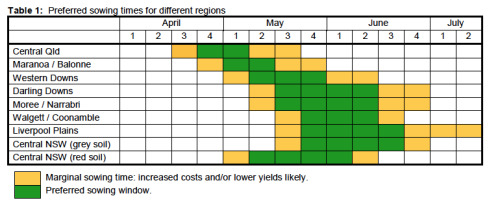Aim for a uniform plant stand on wider rows sown in the later part of the optimum seeding window.
Chickpea variety choices for 2015
by Gordon Cumming, Pulse Australia, National Development Manager
The growing number of chickpea varieties available gives growers more choice than ever before. When choosing varieties to grow, it is essential to consider their susceptibility to ascochyta blight and phytophthora root rot along with yield potential, price potential, marketing opportunities, flowering cold tolerance, maturity timing, lodging resistance and other agronomic features relevant to your growing region.
The three newer varieties, specifically bred for the northern grains region, are PBA Pistol for central Queensland and PBA HatTrick and PBA Boundary for southern Queensland and northern NSW. Some older varieties, still grown for good reasons in some situations, include Kyabra, Jimbour, Moti (CQ only), Flipper and Yorker.
While high yield is a bonus with some varieties it is lost if the variety is susceptible to a disease that you have reason to expect will be a challenge during the coming season.
Ascochyta blight: When comparing yields between varieties, be aware that under high ascochyta blight pressure, varieties with moderate resistance, or less, are more likely to suffer greater yield losses than the resistant lines, even with regular applications of foliar fungicides. PBA Boundary, PBA HatTrick and Flipper offer the highest level of resistance to ascochyta blight however all varieties are susceptible once podding begins.
Nematodes: Chickpea is susceptible to both species of Pratylenchus (root lesion nematodes) and RLN numbers will generally increase under chickpea, affecting subsequent crops. However, PBA HatTrick and PBA Boundary have consistently shown lower Pratylenchus levels compared to Jimbour and Kyabra.
Phytophthora root rot (PRR): Jimbour, PBA HatTrick and Yorker provide the best resistance (MR) to PRR but variety resistance is the least effective way to minimise the risk of yield losses to PRR. Paddock selection is key to managing PRR risk.
Having thought through the variety choices it’s worth re-visiting the first principles of chickpea production to minimise production risks in 2015.
Soil moisture level: Be honest with yourself when estimating the amount of soil moisture that is present in any one paddock. Ideally, I like to have 100 mm of plant available moisture (PAW) before planting chickpea as this is roughly what is needed to achieve a yield of 1.0 t/ha with no in-crop rainfall. We can push this down to 80 mm PAW without significantly increasing our production risk, but when you get down to 60 mm PAW there is high risk of crop failure or at least a negative gross margin unless there is significant and timely in-crop rainfall.
On any of the heavy black earths the soil needs to be wet down to 50 cm, whilst Brigalow, heavy box, grey clay and open downs soils need to be wet down to 70 cm. On any of the western red earths the profile needs to be wet down to 100 cm.
Sowing dates: Consider sowing in the early to mid part of the suggested sowing window for your district. Don’t sow too early as this will only lead to excessive biomass growth and water use prior to flowering. If we have a dry finish and run out of moisture in spring, the result can be significantly reduced yield.
The preferred planting times are: central Queensland, last week of April to early May, south-western Queensland aim for the second or third week of May and on the Darling Downs the best time is the last two weeks of May. Confirm these dates by talking to your advisor or check the Pulse Australia Bulletin ‘Chickpea: Effective Crop Establishment’.
Sourcing planting seed: Clearly a good crop starts with high quality planting seed. By now you should have had germination and vigour tests conducted on all seed lines intended for use this year. If the quality is not suitable i.e. germination below 75% then alternative seed sources need to be found. There is high quality PBA HatTrick and PBA Boundary seed available from your local Seednet partner or reseller as well as Kyabra from your local Heritage Seeds agent.
Be sure that grower-retained seed lots are not contaminated with seed of another variety. Even with a small proportion of seeds from a different variety, there is a risk that disease inoculum will build up on susceptible plants, putting undue pressure on the resistance genes in the moderately resistant plants. The multiplier effect of seed can see the percentage of contaminated seed increasing in successive generations of grower-retained seed. Buying seed from sources outside the certified seed program is illegal and the buyer forfeits their legal rights to compensation if the seed is not true to type.
Plant populations: Do not rely upon your standard seeding rate. Under most conditions the ideal plant population ranges from 20 to 30 plants/m2. To achieve this population calculate the planting rate using the seed weight, germination and establishment percentages of the batch of seed you are planting. With high quality seed this typically falls around 65 kg/ha. Discuss your specific requirements with your advisor or agronomist.
Detailed information concerning planting seed quality, crop establishment including optimum seeding times and disease management strategies can be found in a series of ‘Northern Pulse Bulletins’ on the Pulse Australian website www.pulseaus.com.au by clicking on the ‘Publications’ button or feel free to call me on 0408 923 474 to discuss your needs further.


